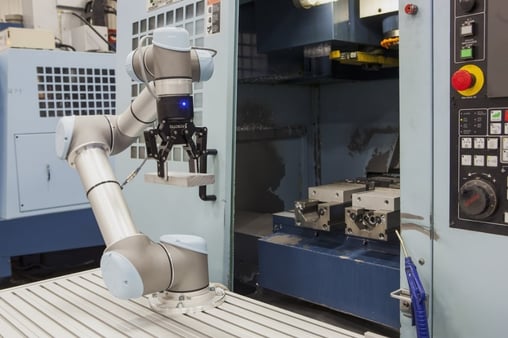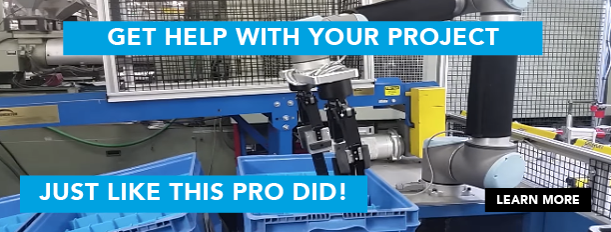How the Role of CNC Operators Has Changed

Posted on Apr 11, 2017 in Manufacturing
6 min read time
Robotic machine tending could revolutionize CNC machine tending. But, where does that leave machine operators? Surprisingly, this change is not as drastic as the changes that came before it. The role of machine operators has changed a lot throughout history.
It's no overstatement to say that machine tools created the modern world. From the first accurate lathe — used by James Watt to create his steam engine — to the first commercially available CNC machine in the 1950s, machine tools have driven many of the world's recent technological revolutions. Without Computer Numerical Control (CNC), low-cost electronics would be impossible, air travel would still be restricted to a few enthusiastic individuals, and small manufacturers would find it impossible to compete with mass-production.
As machines have developed, so has the role of the machine operator. Their role has changed from artisan craftsman to metal worker to paper puncher to CAD designer. The most recent development, robotic machine tending, means that the role of the machine operator is changing again — to robot programmer.
In this article, we map the history of the CNC operator. It turns out, robot machine tending is just another step in a long history of a changing job.

Early History: Ancient Egyptian Two-Man Lathe
Long before computers and the industrial revolution, the Ancient Egyptians developed the first ever machine tool. In around 1300 BCE, they invented the lathe.
Egyptian lathes needed two operators: one to turn the workpiece and the other to cut using a sharpened tool. Many machine tools worked like this right up to the industrial revolution as there was no easy way to turn the workpiece. The Ancient Egyptians used this method to form wood and carve stone bowls. They also introduced the idea of cutting using hard jewels, which we still use today with diamond cutting tools.
18th Century: Machine Operators As Artisan Craftsmen
Fast forward to the 1700s. Machine tool operators, as a separate job, didn't exist. Instead, artisan craftsmen would build machine tools to create their products. These craftsmen would then operate their own machine tools. All machine tools would have been highly customized to the manufacturing needs of the craftsman.
In some ways, this is quite similar to the way that we machine tools today. Mass-production seems to be in decline and small manufacturers are looking for highly-customizable machine tools which can easily be reprogrammed for their rapidly changing products. We no longer build our own machine tools — as the early craftsmen did — but custom tooling and fixturing is still a large part of the machine operator's job.
Accuracy wasn't great with these early machine tools. At the end of the 18th century, James Watt needed an accurate way to manufacture the cylinder for his steam engine. Industrialist John Wilkinson invented an machine which could accurately bore large cylinders, kick-starting the industrial revolution and the rise of machine tools.
19th & 20th Centuries: Modern Machine Tool Operators
The modern job of a machine operator began in the early 1800s. An inventor called Henry Maudslay is considered the founding father of machine tools. He and his employee Joseph Whitworth introduced standardization to manufacturing. It was around this time that Matthew Murray released the first commercial machine tool.
This meant that the job of a machine operator changed again. Standardized machines meant that they no longer had to build custom machine tools, instead they became skilled operators.
By 1840, a whole range of commercial machine tools were available: slide lathes, turret lathes, milling machines, pattern-tracing lathes, screw-cutting lathes and metal planers.
Since then, and right up to the present day, the job of machine operators has included:
- Being able to maintain and operate a wide variety of machine tools.
- Being skilled with hand tools.
- Inspection and metrology to ensure accurate machining.
- Practical knowledge of raw material properties.
Machine operators are skilled technicians. They might not design products themselves, but they can spot bad design and are able to select the right tools and processes for the job.

The Computer Age: CNC Machines Appear
In the 1950s, the first Numerical Control (NC) machines arrived. This sparked an era of rapid changes in the job of machine operators.
John T Parsons was a self-taught engineer. He was manufacturing propellers for the Second World War when he came up with the idea of using punched cards to directly operate machine tools. He encountered a technical problem and collaborated with MIT to overcome it. Together, they produced the first NC milling machine. Parsons was shocked when MIT took over the invention and pushed him off the project. However, the age of NC machines had begun and he is now considered by some to be the father of the second industrial revolution.
The first NC machines stored their programs on punched card. Changing a program would involve repunching the entire card or, for very minor changes, taping over a hole and punching a new one.
The job of machine operators had always included planning out operations. However, this was the first time that operators had to turn their plans into abstract programs. Manual programming took a long time using punched cards — think 8 hours to write a program to mill a single part.
From 1956 onward, computer programming skills also entered the machine operator's job description. The MIT scientists had developed the first CNC programming language, G-Code, using computers to plan the points. Those 8 hours of programming were now reduced to just 15 minutes.
Computer-Aided Design (CAD) also came into the picture around 1960. By as early as 1963, General Motors had produced the first CNC machined prototype from a 3D CAD model.
The job of modern machine operators still includes all of the responsibilities that it did back in 1840. On top of these, machine operators had to learn new skills like programming in G-Code and working with CAD models.
The 21st Century and Beyond: Robot Machine Tending
The latest development marks yet another change for CNC machine operators. Robotic machine tending allows small manufacturers to increase their throughput by using a robot to load and unload parts into the CNC machine.
The skills required to program a robot are a natural progression from those required to program CNC machines. In fact, if you know G-Code you will find it very easy to program a collaborative robot.
As a result, this latest change in the job of a machine operator is not nearly so drastic as some of the changes that have come before it. Machine operators still require the same skills that they did in the past. Now, they can add "robot programmer" to the list.
Do you like learning about the history of robotics? You might like our previous posts:
Robotics' History: From GM Work Floor to Collaborative Robots
A History of Robot Programming Languages
A History of Robotic Force Torque Sensors
3-Finger Adaptive Robot Gripper History
Why is Everyone Investing in Robotics? A History
The Real Reason Workers Distrust New Technology
How easy do you find robot programming compared to other CNC machine work? What skills do you think are most important for CNC operators? Do you have any questions about machine tending? Tell us in the comments below or join the discussion on LinkedIn, Twitter, Facebook or the DoF professional robotics community.






Leave a comment